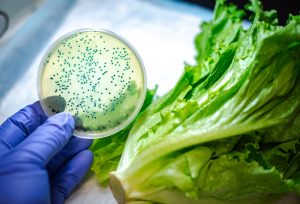
Photo courtesy Purdue University
Researchers at Purdue University, Indiana, have developed a treatment to infuse a hardened metal surface with naturally occurring antimicrobial peptides. The technology is expected to create a hard metal surface that kills bacteria trying to attach to the surface.
“When we create an oxidized metal surface with nanometer-wide and micrometer-deep cracks, peptides can be infused in these microscopic cracks with a simple wet process,” said David Bahr, head and professor of materials engineering at Purdue, who leads the team. “As an additional benefit, the process can color several metals, providing a visual indication of when the surface is no longer antimicrobial.”
Bahr said this technology applies primarily to food processing and cutting surfaces, which can be especially vulnerable to bacteria growth and attachment given the materials and surface designs.
“Our technology can help ensure that if a food processing facility was chopping salad greens, bacteria would not transfer from a contaminated surface to a cutting tool, thereby contaminating many more parts,” Bahr said. “When used in conjunction with food washing and other safe handling, this should allow fewer outbreaks of food-borne illness.”
Preliminary testing verified the treated surfaces provide antibacterial properties in excess of the untreated surfaces. The material stored in the cracks releases over time, leading to extended times of antimicrobial resistance.
The oxidation process creates an optically colored material, which provides a simple visual indicator of wear or degradation in antimicrobial performance.
The process has been demonstrated on stainless steel and titanium and is applicable to a wide range of commercial metal alloys.





My question would be what percent of the bacteria is killed with this antimicrobial peptide? Silver and gold are inherently antimicrobial but to add them to stainless would increase the price of stainless. Perhaps these peptides aren’t silver or gold. Can the peptides differentiate between good bacteria and harmful bacteria? If this doesn’t kill 100% of the harmful bacteria, it just leaves stronger bacteria survivors, which is no benefit.